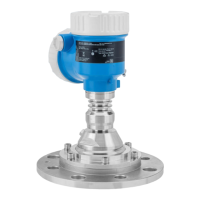Micropilot FMR67B PROFINET with Ethernet-APL
Endress+Hauser 5
D = (c ∆t) / 2
where c is the speed of propagation of the wave.
In summary, D can be calculated from the measured difference frequency Δf. D is then used to
determine the content of the tank or silo.
Input
Measured variable
The measured variable is the distance between the reference point and the product surface. The level
is calculated based on "E", the empty distance entered.
Measuring range
The start of the measuring range is the point where the beam hits the floor. Levels below this point
cannot be measured, particularly in the case of conical outlets. An alignment unit can be used to
increase the maximum measuring range in such applications.
Maximum measuring range
The maximum measuring range depends on the antenna size and design.
Antenna Maximum measuring range
Horn, 316L, 65 mm (2.6 in) 125 m (410 ft)
Drip-off, PTFE, 50 mm (2 in) 50 m (164 ft)
Flush mount, PTFE, 80 mm (3 in) 125 m (410 ft)
Usable measuring range
The usable measuring range depends on the antenna size, the medium's reflective properties, the
installation position and any possible interference reflections.
In principle, measurement is possible up to the tip of the antenna.
Depending on the position of the product (angle of repose) and to avoid any material damage from
abrasive media and deposit buildup on the antenna, the end of the measuring range should be
selected 10 mm (0.4 in) before the tip of the antenna.

